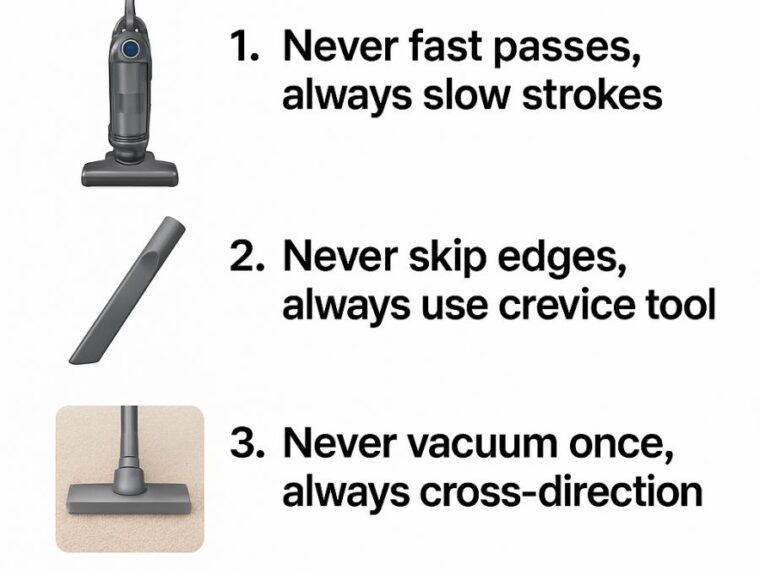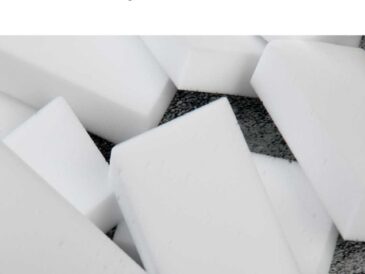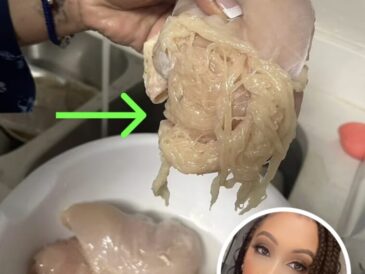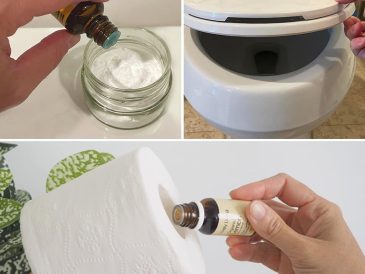Vacuuming carpets might seem like a straightforward task—plug in the vacuum, run it over the carpet, and you’re done. However, many people are unaware that improper vacuuming techniques can lead to inefficient cleaning and even damage to your carpet over time. Not only does this leave your carpets looking lackluster, but it can also reduce the lifespan of the fibers.
In this article, we will delve into the common mistakes people make when vacuuming their carpets and provide practical steps to ensure your carpets are thoroughly clean and well-maintained. By adopting these expert-recommended techniques, you can achieve a cleaner, healthier home environment while preserving the beauty and integrity of your carpets.
1. Use Slow Strokes for Optimal Cleaning
Rushing through vacuuming might save you a few minutes, but it won’t give you the best results. Carpet fibers trap dirt, dust, and allergens deep within their layers, which requires a thorough approach to remove. For optimal cleaning, move the vacuum slowly over the carpet, giving it enough time to suck up debris. Experts suggest using strokes that are about 2-3 feet in length, moving the vacuum forward and then slowly pulling it back over the same area to allow the suction to pick up as much dirt as possible.
By taking your time, you ensure that the vacuum’s suction has the opportunity to penetrate deep into the carpet fibers, providing a more thorough clean. Remember, the goal is not just to remove visible dirt, but also to remove the invisible dust and allergens that can affect indoor air quality.
2. Don’t Skip the Edges: Utilize the Crevice Tool
Edges and corners of rooms often get neglected during vacuuming, yet these areas can accumulate significant dust and debris over time. Most standard vacuum cleaners come with a crevice tool specifically designed to tackle these hard-to-reach areas. Use the crevice tool to clean along the edges of the room and in tight corners.
For best results, run the crevice tool slowly along the baseboards and around any furniture or obstacles. This will help ensure that no dirt is left behind in these often-overlooked areas. A little extra attention to detail goes a long way in maintaining a clean carpet throughout your entire space.
3. Vacuum in Cross-Direction for Thoroughness
Vacuuming in a single direction might seem efficient, but it often leaves dirt behind. For a more thorough clean, vacuum in a cross-directional pattern. Start by vacuuming the carpet in one direction, and then vacuum again at a 90-degree angle to the first pass.
This technique ensures that you reach dirt from different angles and that the carpet fibers are lifted and repositioned, making it easier for the vacuum to pick up debris. Cross-directional vacuuming is especially useful for high-traffic areas where dirt and grime can become deeply embedded in the carpet fibers.
4. Regularly Clean or Replace Vacuum Filters
One of the most overlooked aspects of vacuum maintenance is the condition of the vacuum’s filter. A clogged or dirty filter can significantly reduce the vacuum’s suction power, leading to less effective cleaning. Depending on the model, vacuum filters should be cleaned or replaced every 3 to 6 months, or more frequently if you have pets or allergies.
Check your vacuum’s manual for specific instructions on maintaining the filters. Some filters are washable, while others need to be replaced. By keeping the filters clean, you ensure that your vacuum operates at peak efficiency, providing maximum suction power for every use.
5. Adjust the Vacuum Height for Carpet Type
Many vacuums come with adjustable height settings to accommodate different carpet types and pile heights. Using the correct height setting is crucial for effective cleaning. If the vacuum is set too high, it won’t be able to pick up dirt effectively; if it’s set too low, it could damage the carpet fibers and strain the vacuum motor.
For low-pile carpets, set the vacuum to a lower height to ensure the brush roll can reach the fibers. For high-pile or shag carpets, raise the vacuum height to prevent the vacuum from getting stuck or damaging the carpet. Regularly adjusting the height not only improves cleaning performance but also helps extend the life of your carpets.
6. Empty the Dust Bin Frequently
A full dust bin can significantly reduce your vacuum’s effectiveness by restricting airflow and reducing suction power. To maintain optimal performance, empty the dust bin before it reaches the full line, typically when it is about two-thirds full. This is especially important if you have a bagless vacuum.
Regularly emptying the dust bin ensures that the vacuum can operate efficiently and prevents the motor from overworking. Additionally, a clean dust bin reduces the risk of odors and allergens being released back into the air during vacuuming.
7. Use Baking Soda for Odor Control
Over time, carpets can develop unpleasant odors from spills, pets, or everyday use. To combat this, sprinkle a thin layer of baking soda over the carpet before vacuuming. Allow it to sit for 15-30 minutes to absorb odors and then vacuum as usual.
Baking soda is a natural deodorizer that neutralizes odors without leaving any residue. Regular use can help keep your carpets smelling fresh and clean, making your home more inviting. This simple step adds an extra layer of freshness to your vacuuming routine.
8. Maintain the Vacuum’s Brush Roll
The brush roll, or beater bar, is essential for loosening dirt and debris from carpet fibers, but it can become tangled with hair, string, and other debris over time. To keep it functioning effectively, check the brush roll regularly and remove any obstructions.
Turn off and unplug the vacuum before cleaning the brush roll. Use scissors or a seam ripper to carefully cut away any tangled material. Keeping the brush roll clean ensures that it can agitate the carpet fibers properly, enhancing the vacuum’s cleaning performance.
9. Choose the Right Vacuum for Your Carpet
Different carpets require different types of vacuums to be cleaned effectively. For example, a vacuum with strong suction and a brush roll is ideal for thick or high-pile carpets, while a lightweight model might be better suited for delicate or low-pile carpets.
Consider other factors such as the presence of pets, allergies, and the overall size of your home when selecting a vacuum. Investing in the right vacuum for your specific needs can make a significant difference in cleaning efficiency and the longevity of your carpets.
10. Avoid Overcrowding: Move Furniture
Furniture can be a significant barrier to effective vacuuming. To ensure all areas of the carpet are cleaned, make a habit of moving furniture periodically. Even moving items a few inches can reveal hidden dirt and debris that accumulates under and around them.
For larger furniture that is difficult to move, consider using furniture sliders or enlisting help. By rotating the position of furniture occasionally, you can prevent uneven wear on the carpet and ensure a more thorough clean.
11. Incorporate Regular Vacuuming into Your Routine
Consistency is key when it comes to maintaining clean carpets. Establish a regular vacuuming schedule that suits your household’s needs. For homes with pets or high foot traffic, vacuuming 2-3 times a week might be necessary. For less busy homes, once a week may suffice
Regular vacuuming prevents dirt and debris from becoming embedded in the carpet fibers, making each cleaning session more effective. A consistent routine not only keeps your carpets looking their best but also contributes to a healthier indoor environment.





